单元教案
图片预览
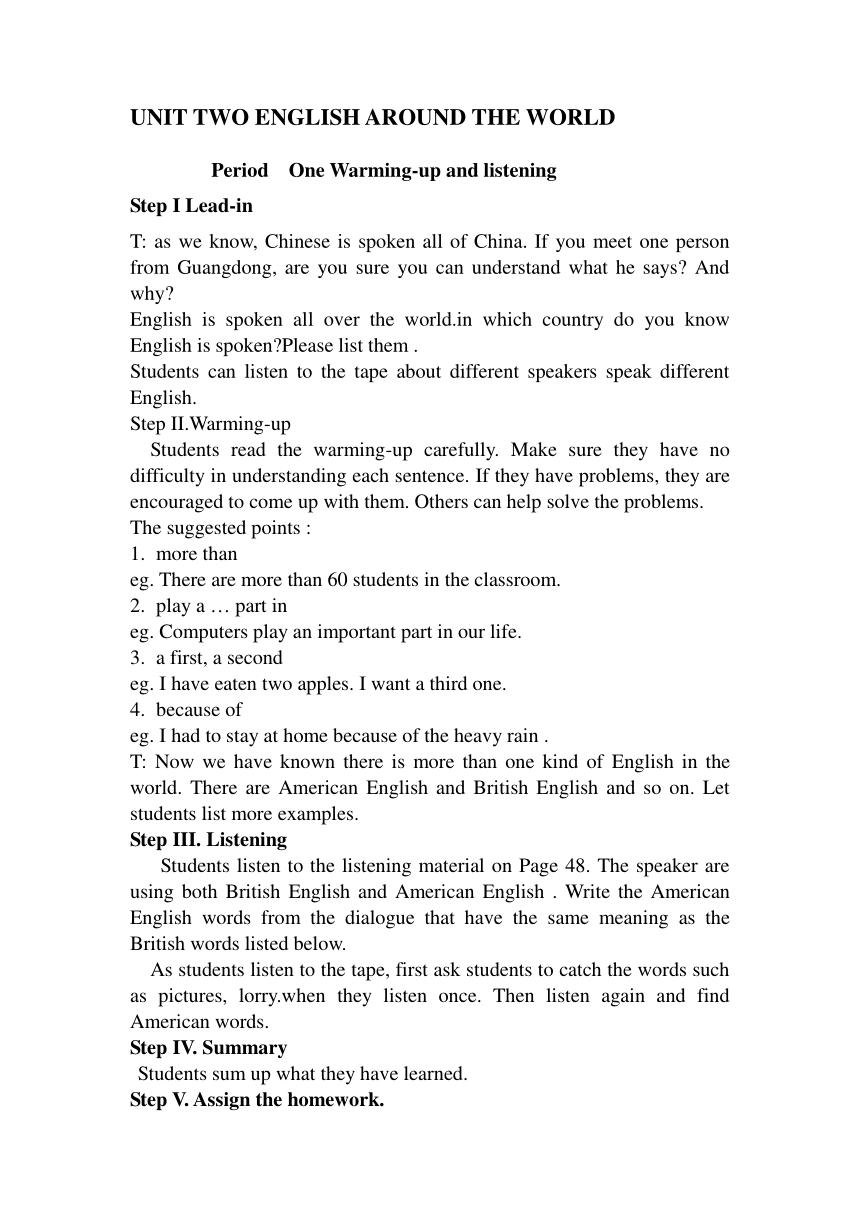
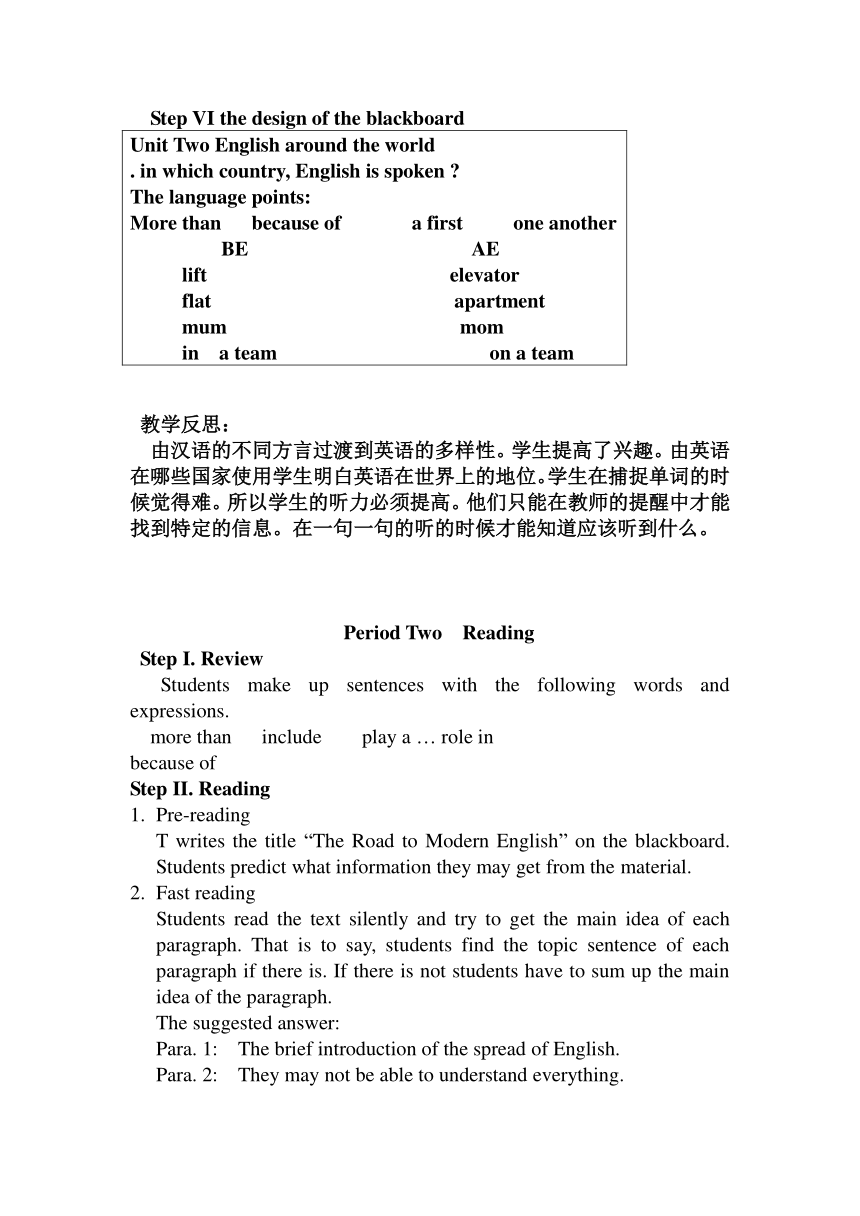
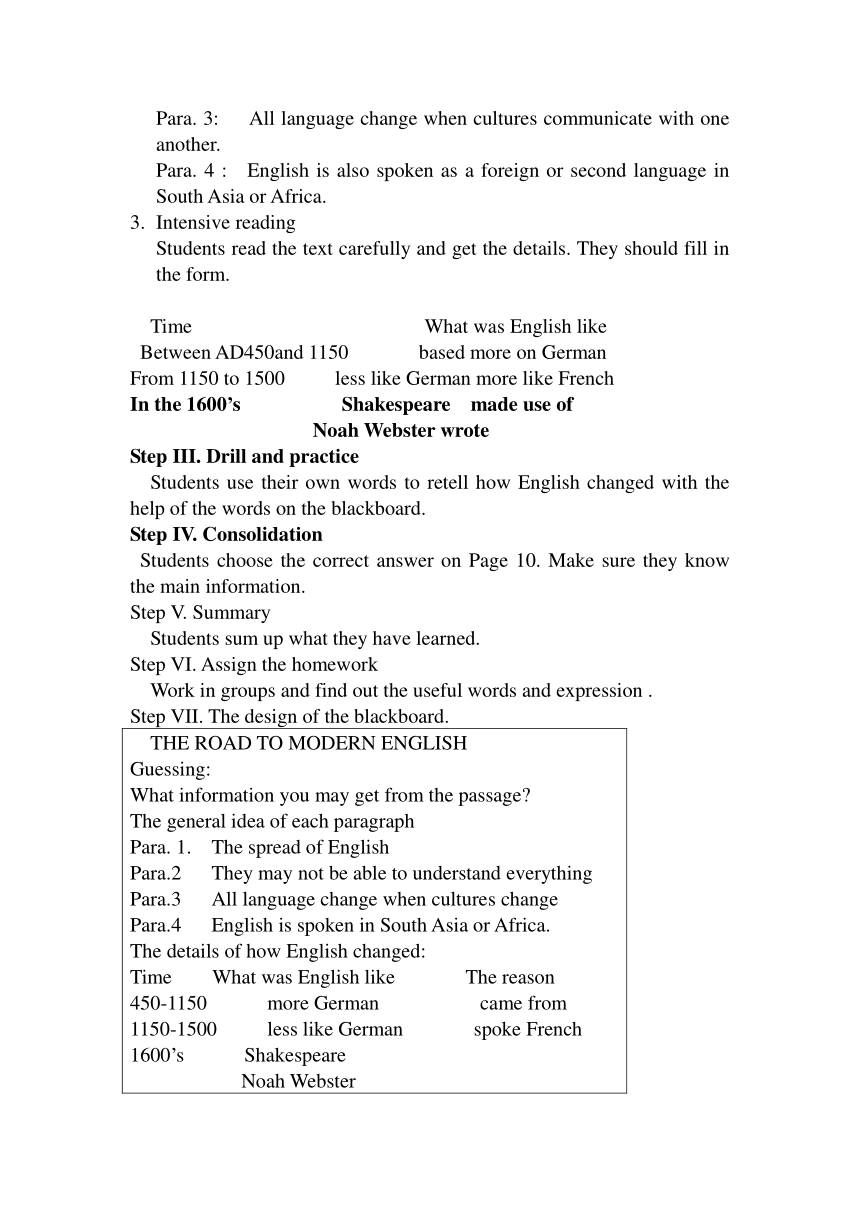
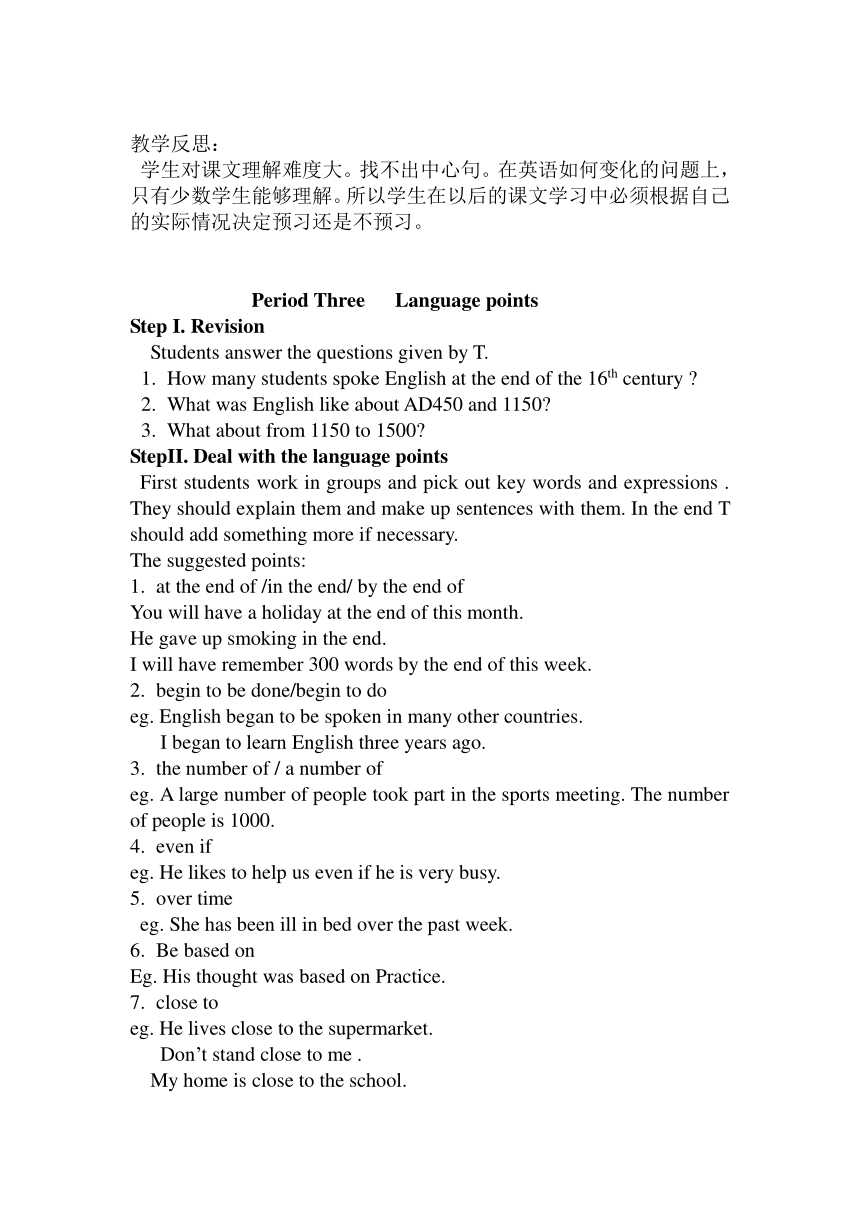
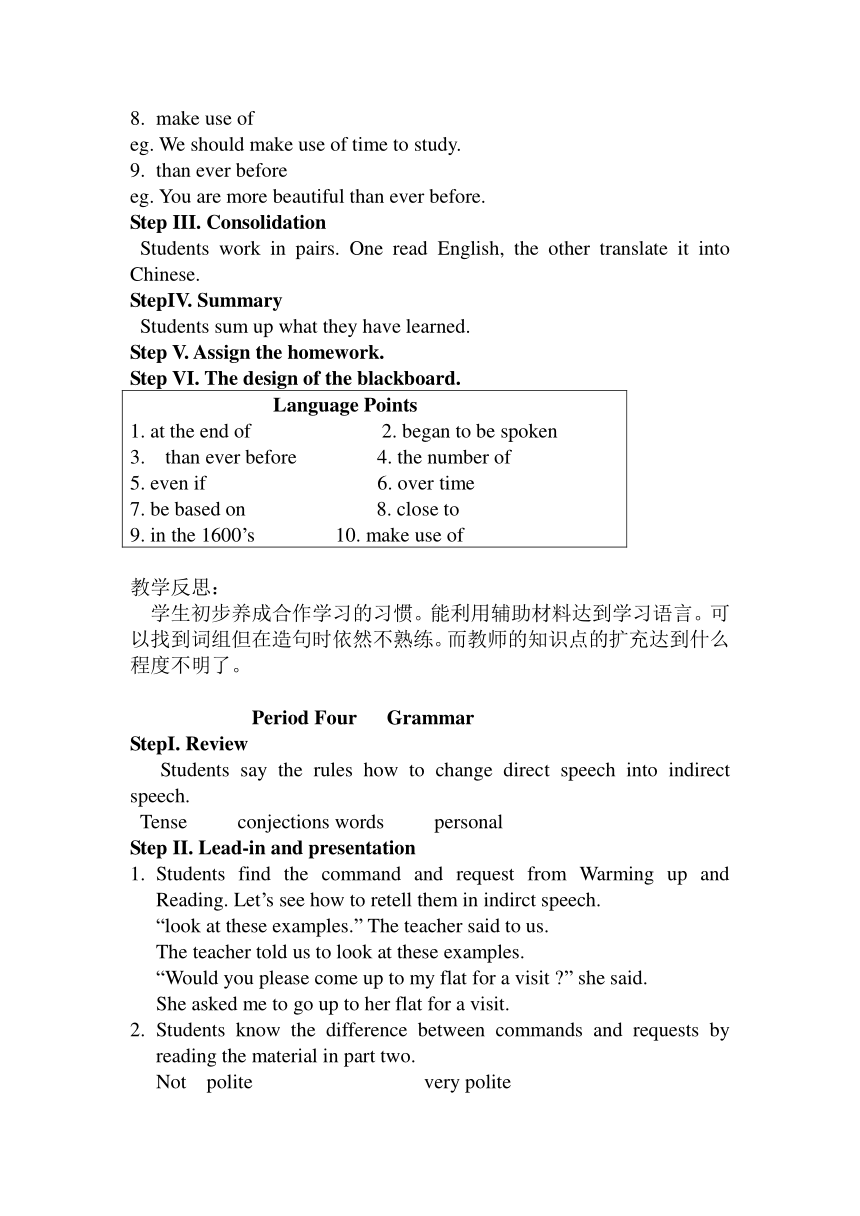
文档简介
UNIT TWO ENGLISH AROUND THE WORLD
Period One Warming-up and listening
Step I Lead-in
T: as we know, Chinese is spoken all of China. If you meet one person from Guangdong, are you sure you can understand what he says And why
English is spoken all over the world.in which country do you know English is spoken Please list them .
Students can listen to the tape about different speakers speak different English.
Step II.Warming-up
Students read the warming-up carefully. Make sure they have no difficulty in understanding each sentence. If they have problems, they are encouraged to come up with them. Others can help solve the problems.
The suggested points :
1. more than
eg. There are more than 60 students in the classroom.
2. play a … part in
puters play an important part in our life.
3. a first, a second
eg. I have eaten two apples. I want a third one.
4. because of
eg. I had to stay at home because of the heavy rain .
T: Now we have known there is more than one kind of English in the world. There are American English and British English and so on. Let students list more examples.
Step III. Listening
Students listen to the listening material on Page 48. The speaker are using both British English and American English . Write the American English words from the dialogue that have the same meaning as the British words listed below.
As students listen to the tape, first ask students to catch the words such as pictures, lorry.when they listen once. Then listen again and find American words.
Step IV. Summary
Students sum up what they have learned.
Step V. Assign the homework.
Step VI the design of the blackboard
Unit Two English around the world. in which country, English is spoken The language points:More than because of a first one another BE AElift elevatorflat apartmentmum momin a team on a team
教学反思:
由汉语的不同方言过渡到英语的多样性。学生提高了兴趣。由英语在哪些国家使用学生明白英语在世界上的地位。学生在捕捉单词的时候觉得难。所以学生的听力必须提高。他们只能在教师的提醒中才能找到特定的信息。在一句一句的听的时候才能知道应该听到什么。
Period Two Reading
Step I. Review
Students make up sentences with the following words and expressions.
more than include play a … role in
because of
Step II. Reading
1. Pre-reading
T writes the title “The Road to Modern English” on the blackboard. Students predict what information they may get from the material.
2. Fast reading
Students read the text silently and try to get the main idea of each paragraph. That is to say, students find the topic sentence of each paragraph if there is. If there is not students have to sum up the main idea of the paragraph.
The suggested answer:
Para. 1: The brief introduction of the spread of English.
Para. 2: They may not be able to understand everything.
Para. 3: All language change when cultures communicate with one another.
Para. 4 : English is also spoken as a foreign or second language in South Asia or Africa.
3. Intensive reading
Students read the text carefully and get the details. They should fill in the form.
Time What was English like
Between AD450and 1150 based more on German
From 1150 to 1500 less like German more like French
In the 1600’s Shakespeare made use of
Noah Webster wrote
Step III. Drill and practice
Students use their own words to retell how English changed with the help of the words on the blackboard.
Step IV. Consolidation
Students choose the correct answer on Page 10. Make sure they know the main information.
Step V. Summary
Students sum up what they have learned.
Step VI. Assign the homework
Work in groups and find out the useful words and expression .
Step VII. The design of the blackboard.
THE ROAD TO MODERN ENGLISHGuessing:What information you may get from the passage The general idea of each paragraphPara. 1. The spread of EnglishPara.2 They may not be able to understand everythingPara.3 All language change when cultures changePara.4 English is spoken in South Asia or Africa.The details of how English changed:Time What was English like The reason450-1150 more German came from1150-1500 less like German spoke French1600’s Shakespeare Noah Webster
教学反思:
学生对课文理解难度大。找不出中心句。在英语如何变化的问题上,只有少数学生能够理解。所以学生在以后的课文学习中必须根据自己的实际情况决定预习还是不预习。
Period Three Language points
Step I. Revision
Students answer the questions given by T.
1. How many students spoke English at the end of the 16th century
2. What was English like about AD450 and 1150
3. What about from 1150 to 1500
StepII. Deal with the language points
First students work in groups and pick out key words and expressions . They should explain them and make up sentences with them. In the end T should add something more if necessary.
The suggested points:
1. at the end of /in the end/ by the end of
You will have a holiday at the end of this month.
He gave up smoking in the end.
I will have remember 300 words by the end of this week.
2. begin to be done/begin to do
eg. English began to be spoken in many other countries.
I began to learn English three years ago.
3. the number of / a number of
eg. A large number of people took part in the sports meeting. The number of people is 1000.
4. even if
eg. He likes to help us even if he is very busy.
5. over time
eg. She has been ill in bed over the past week.
6. Be based on
Eg. His thought was based on Practice.
7. close to
eg. He lives close to the supermarket.
Don’t stand close to me .
My home is close to the school.
8. make use of
eg. We should make use of time to study.
9. than ever before
eg. You are more beautiful than ever before.
Step III. Consolidation
Students work in pairs. One read English, the other translate it into Chinese.
StepIV. Summary
Students sum up what they have learned.
Step V. Assign the homework.
Step VI. The design of the blackboard.
Language Points1. at the end of 2. began to be spoken3. than ever before 4. the number of 5. even if 6. over time7. be based on 8. close to9. in the 1600’s 10. make use of
教学反思:
学生初步养成合作学习的习惯。能利用辅助材料达到学习语言。可以找到词组但在造句时依然不熟练。而教师的知识点的扩充达到什么程度不明了。
Period Four Grammar
StepI. Review
Students say the rules how to change direct speech into indirect speech.
Tense conjections words personal
Step II. Lead-in and presentation
1. Students find the command and request from Warming up and Reading. Let’s see how to retell them in indirct speech.
“look at these examples.” The teacher said to us.
The teacher told us to look at these examples.
“Would you please come up to my flat for a visit ” she said.
She asked me to go up to her flat for a visit.
2. Students know the difference between commands and requests by reading the material in part two.
Not polite very polite
Open the door Please open…. Would you please…
3. Students work in pairs. One student give the command, the other changes it into a request.
eg. Close the door. Could you please…
4. Students use different verbs to change requests or commands into indirect speech. For example. Ask tell order etc.
eg.” Could you take the dog for a walk ” Mary said.
Mary asked his brother to take…..
“Don’t close the door.” The boss said.
The boss told him not to close the door.
Step III. Drill and practice
Students work in groups of three,think of at least three commands that your parents and teachers usually give. You may follow these steps.
Choose who is to give the first command.
Ask another person in your group to tell somebody what you said.
The third person will change the request from direct into indirect speech.
Change roles so each person gets the chance to give some command and turn them into indirect speech.
EXAMPlE: S1(as a teacher) Please don’t talk in class.
S2: What did our teacher tell us
S3: She told us not to talk in class.
If there is time, students can practise how to change statement, general question, special question into indirect speech. (they can have a competition)
Step IV. Summary
Students sum up how to change direct speech into indirect speech.
Step V. Assign the homework.
Step VI. The design of the blackboard
Commands and RequestsOpen /Don’t the door tell sb to/not to doPlease open the door. Ask sb to do Could you please open… Ask sb to do
教学反思:
学生在竞争中运用语言。把语法课变成实践活动课。参与人数多。学生的积极性高。学生掌握知识的能力提高。
Period Five Using language
Step I. Review
Students act out the dialogue using the commands or requests.
Step II. Lead-in
T: in your opinion, what is standard English
Ss give different answer.
Step III. Reading
1. Students read the passage fast and find out the answer to the questions.
Why has American English have so many dialects
2. Students work in groups and find the useful words and expressions. They try to find the usage of them from the sentence.
The suggested points:
. Believe it or not
Believe it or not, he passed the exam.
. expect
You are expected to go to university.
Your parents expect you to go to university.
.play a part in play a role in
Water plays an important part in our life.
Step III. Activity 1.
Students work in pairs and talk about Chinese dialects they have ever heard.
Step III. Activity 2.
Students work in groups and choose one topic to discuss.
1. Tell an interesting story that shows great difference between dialects in Chinese.
2. Why is Putonghua is used in China
Step IV. Listening
Students listen to tape and begin to be familiar with American dialects . Students just appreciate it.
Step V. Summary
Students sum up what they have learned .
Step VI. Assign the homework.
Step VII. The design of the blackboard.
Reading and TalkingWhy does American English have so many dialects The points:. believe it or not . expectplay a part in
教学反思:
学生对于各地地方方言很感兴趣。积极参与讨论。但多数局限于东北方言。对于一个固定题目,学生用英语表达欠佳。可以这么说用汉语都可以说上几句但是用英语则能一句的就不多。
Period Six Speaking and Writing
Step I. Warming-up
1. Greet each other
2. Students act out the dialogue.
Step II. Speaking
First students read the dialogue aloud and list the words that were confusing to Amy and her friends.
Amy lady
subway underground
left left-handed side
keep going straight straight on
two blocks two streets.
Step III. Activity one
Students work in pairs and prepare their role-play. Now you are at Liwei Senior School. You want to get to the railway station. Please make up the dialogue similar to the one in the speaking part. One student draw a map on the blackboard before the class.
Step IV. Writing
1. Students read the writing by themselves for five minutes. Make sure they know how to brainstorm.
2. Students do brainstorming with a partner on the following topic. My experience of leaning English.
My Problems Ideas for improvement
Why I like/I don’t like English
My future with English
3. The leader present their result.
4. Students begin to write composition. If they can’t finish it in class. After class they should hand it in.
Step V. Summary
Students sum up what they have learned.
Step VI. Assign the homework.
Step VII. The design of the blackboard.
Speaking and WritingThe map on the blackboard Amy lady Sumway underground Left left-hand side Blocks streetsBrainstormingMy problems Ideas for improvementWhy I like/don’t like English
学生准确地把从利伟高中到火车站的地图画在黑板上。令人非常吃惊。学生有极其高的能力。这给其他学生以很大的动力。在大脑风暴的过程中,每个学生发挥自己的创造性,想出许多令人意想不到的想法。学生潜力无限。但是要完成作文。时间则不够。只能把它做为作业。
Period Seven Review
Step I. Greeting
1. say hello to each other
2. students make up the dialogue.
StepII. Quiz.
Students take out a piece of paper and write their names and numbers on it . They will have a dictation of words and expressions.
The words and expressions:
include native modern culture present
usage identity government command boss
recognize direction block phrase standard
play a role in because of come up
make a list of believe it or not close to
at the end of than ever before
Translation:
1. There is more than one book on the desk.
2. You look more beautiful than ever before.
3. There are a number of students playing football on the playground. The number of them is 12.
4. I will go home at the end of this month.
5. Computers play an important part in our life.
6. Your behavior is based on your thoughts.
7. Don’t get close to me.
8. The train is about to leave.
9. Make a list of the things you want to buy.
10. My home is close to my school.
Step III. Checking
Students exchange the paper and check the answer, marking the paper after T gives them correct answers.
StepIV. Learn the new words in Unit Three.
First students read the words by themselves. Then some student read ,others read follow him/her. At last students read follow the teacher.
Step V. Assign the homework
Step VI. The design of the blackboard.
Unit Two1. more than one 2. a number of /the number of 3. end 4. play a part in5. be based on 6. close to 7. be about to do 8 There be ….+V+ing.
教学反思:
学生在翻译句子的时候有的学生能够提出不同的表达方式。说明他们不再局限于本单元的词的用法。不错。但大多数学生对于句子的翻译有的甚至是书上的原句也不会。所以有一部分学生必须背诵书上的句子。
Period One Warming-up and listening
Step I Lead-in
T: as we know, Chinese is spoken all of China. If you meet one person from Guangdong, are you sure you can understand what he says And why
English is spoken all over the world.in which country do you know English is spoken Please list them .
Students can listen to the tape about different speakers speak different English.
Step II.Warming-up
Students read the warming-up carefully. Make sure they have no difficulty in understanding each sentence. If they have problems, they are encouraged to come up with them. Others can help solve the problems.
The suggested points :
1. more than
eg. There are more than 60 students in the classroom.
2. play a … part in
puters play an important part in our life.
3. a first, a second
eg. I have eaten two apples. I want a third one.
4. because of
eg. I had to stay at home because of the heavy rain .
T: Now we have known there is more than one kind of English in the world. There are American English and British English and so on. Let students list more examples.
Step III. Listening
Students listen to the listening material on Page 48. The speaker are using both British English and American English . Write the American English words from the dialogue that have the same meaning as the British words listed below.
As students listen to the tape, first ask students to catch the words such as pictures, lorry.when they listen once. Then listen again and find American words.
Step IV. Summary
Students sum up what they have learned.
Step V. Assign the homework.
Step VI the design of the blackboard
Unit Two English around the world. in which country, English is spoken The language points:More than because of a first one another BE AElift elevatorflat apartmentmum momin a team on a team
教学反思:
由汉语的不同方言过渡到英语的多样性。学生提高了兴趣。由英语在哪些国家使用学生明白英语在世界上的地位。学生在捕捉单词的时候觉得难。所以学生的听力必须提高。他们只能在教师的提醒中才能找到特定的信息。在一句一句的听的时候才能知道应该听到什么。
Period Two Reading
Step I. Review
Students make up sentences with the following words and expressions.
more than include play a … role in
because of
Step II. Reading
1. Pre-reading
T writes the title “The Road to Modern English” on the blackboard. Students predict what information they may get from the material.
2. Fast reading
Students read the text silently and try to get the main idea of each paragraph. That is to say, students find the topic sentence of each paragraph if there is. If there is not students have to sum up the main idea of the paragraph.
The suggested answer:
Para. 1: The brief introduction of the spread of English.
Para. 2: They may not be able to understand everything.
Para. 3: All language change when cultures communicate with one another.
Para. 4 : English is also spoken as a foreign or second language in South Asia or Africa.
3. Intensive reading
Students read the text carefully and get the details. They should fill in the form.
Time What was English like
Between AD450and 1150 based more on German
From 1150 to 1500 less like German more like French
In the 1600’s Shakespeare made use of
Noah Webster wrote
Step III. Drill and practice
Students use their own words to retell how English changed with the help of the words on the blackboard.
Step IV. Consolidation
Students choose the correct answer on Page 10. Make sure they know the main information.
Step V. Summary
Students sum up what they have learned.
Step VI. Assign the homework
Work in groups and find out the useful words and expression .
Step VII. The design of the blackboard.
THE ROAD TO MODERN ENGLISHGuessing:What information you may get from the passage The general idea of each paragraphPara. 1. The spread of EnglishPara.2 They may not be able to understand everythingPara.3 All language change when cultures changePara.4 English is spoken in South Asia or Africa.The details of how English changed:Time What was English like The reason450-1150 more German came from1150-1500 less like German spoke French1600’s Shakespeare Noah Webster
教学反思:
学生对课文理解难度大。找不出中心句。在英语如何变化的问题上,只有少数学生能够理解。所以学生在以后的课文学习中必须根据自己的实际情况决定预习还是不预习。
Period Three Language points
Step I. Revision
Students answer the questions given by T.
1. How many students spoke English at the end of the 16th century
2. What was English like about AD450 and 1150
3. What about from 1150 to 1500
StepII. Deal with the language points
First students work in groups and pick out key words and expressions . They should explain them and make up sentences with them. In the end T should add something more if necessary.
The suggested points:
1. at the end of /in the end/ by the end of
You will have a holiday at the end of this month.
He gave up smoking in the end.
I will have remember 300 words by the end of this week.
2. begin to be done/begin to do
eg. English began to be spoken in many other countries.
I began to learn English three years ago.
3. the number of / a number of
eg. A large number of people took part in the sports meeting. The number of people is 1000.
4. even if
eg. He likes to help us even if he is very busy.
5. over time
eg. She has been ill in bed over the past week.
6. Be based on
Eg. His thought was based on Practice.
7. close to
eg. He lives close to the supermarket.
Don’t stand close to me .
My home is close to the school.
8. make use of
eg. We should make use of time to study.
9. than ever before
eg. You are more beautiful than ever before.
Step III. Consolidation
Students work in pairs. One read English, the other translate it into Chinese.
StepIV. Summary
Students sum up what they have learned.
Step V. Assign the homework.
Step VI. The design of the blackboard.
Language Points1. at the end of 2. began to be spoken3. than ever before 4. the number of 5. even if 6. over time7. be based on 8. close to9. in the 1600’s 10. make use of
教学反思:
学生初步养成合作学习的习惯。能利用辅助材料达到学习语言。可以找到词组但在造句时依然不熟练。而教师的知识点的扩充达到什么程度不明了。
Period Four Grammar
StepI. Review
Students say the rules how to change direct speech into indirect speech.
Tense conjections words personal
Step II. Lead-in and presentation
1. Students find the command and request from Warming up and Reading. Let’s see how to retell them in indirct speech.
“look at these examples.” The teacher said to us.
The teacher told us to look at these examples.
“Would you please come up to my flat for a visit ” she said.
She asked me to go up to her flat for a visit.
2. Students know the difference between commands and requests by reading the material in part two.
Not polite very polite
Open the door Please open…. Would you please…
3. Students work in pairs. One student give the command, the other changes it into a request.
eg. Close the door. Could you please…
4. Students use different verbs to change requests or commands into indirect speech. For example. Ask tell order etc.
eg.” Could you take the dog for a walk ” Mary said.
Mary asked his brother to take…..
“Don’t close the door.” The boss said.
The boss told him not to close the door.
Step III. Drill and practice
Students work in groups of three,think of at least three commands that your parents and teachers usually give. You may follow these steps.
Choose who is to give the first command.
Ask another person in your group to tell somebody what you said.
The third person will change the request from direct into indirect speech.
Change roles so each person gets the chance to give some command and turn them into indirect speech.
EXAMPlE: S1(as a teacher) Please don’t talk in class.
S2: What did our teacher tell us
S3: She told us not to talk in class.
If there is time, students can practise how to change statement, general question, special question into indirect speech. (they can have a competition)
Step IV. Summary
Students sum up how to change direct speech into indirect speech.
Step V. Assign the homework.
Step VI. The design of the blackboard
Commands and RequestsOpen /Don’t the door tell sb to/not to doPlease open the door. Ask sb to do Could you please open… Ask sb to do
教学反思:
学生在竞争中运用语言。把语法课变成实践活动课。参与人数多。学生的积极性高。学生掌握知识的能力提高。
Period Five Using language
Step I. Review
Students act out the dialogue using the commands or requests.
Step II. Lead-in
T: in your opinion, what is standard English
Ss give different answer.
Step III. Reading
1. Students read the passage fast and find out the answer to the questions.
Why has American English have so many dialects
2. Students work in groups and find the useful words and expressions. They try to find the usage of them from the sentence.
The suggested points:
. Believe it or not
Believe it or not, he passed the exam.
. expect
You are expected to go to university.
Your parents expect you to go to university.
.play a part in play a role in
Water plays an important part in our life.
Step III. Activity 1.
Students work in pairs and talk about Chinese dialects they have ever heard.
Step III. Activity 2.
Students work in groups and choose one topic to discuss.
1. Tell an interesting story that shows great difference between dialects in Chinese.
2. Why is Putonghua is used in China
Step IV. Listening
Students listen to tape and begin to be familiar with American dialects . Students just appreciate it.
Step V. Summary
Students sum up what they have learned .
Step VI. Assign the homework.
Step VII. The design of the blackboard.
Reading and TalkingWhy does American English have so many dialects The points:. believe it or not . expectplay a part in
教学反思:
学生对于各地地方方言很感兴趣。积极参与讨论。但多数局限于东北方言。对于一个固定题目,学生用英语表达欠佳。可以这么说用汉语都可以说上几句但是用英语则能一句的就不多。
Period Six Speaking and Writing
Step I. Warming-up
1. Greet each other
2. Students act out the dialogue.
Step II. Speaking
First students read the dialogue aloud and list the words that were confusing to Amy and her friends.
Amy lady
subway underground
left left-handed side
keep going straight straight on
two blocks two streets.
Step III. Activity one
Students work in pairs and prepare their role-play. Now you are at Liwei Senior School. You want to get to the railway station. Please make up the dialogue similar to the one in the speaking part. One student draw a map on the blackboard before the class.
Step IV. Writing
1. Students read the writing by themselves for five minutes. Make sure they know how to brainstorm.
2. Students do brainstorming with a partner on the following topic. My experience of leaning English.
My Problems Ideas for improvement
Why I like/I don’t like English
My future with English
3. The leader present their result.
4. Students begin to write composition. If they can’t finish it in class. After class they should hand it in.
Step V. Summary
Students sum up what they have learned.
Step VI. Assign the homework.
Step VII. The design of the blackboard.
Speaking and WritingThe map on the blackboard Amy lady Sumway underground Left left-hand side Blocks streetsBrainstormingMy problems Ideas for improvementWhy I like/don’t like English
学生准确地把从利伟高中到火车站的地图画在黑板上。令人非常吃惊。学生有极其高的能力。这给其他学生以很大的动力。在大脑风暴的过程中,每个学生发挥自己的创造性,想出许多令人意想不到的想法。学生潜力无限。但是要完成作文。时间则不够。只能把它做为作业。
Period Seven Review
Step I. Greeting
1. say hello to each other
2. students make up the dialogue.
StepII. Quiz.
Students take out a piece of paper and write their names and numbers on it . They will have a dictation of words and expressions.
The words and expressions:
include native modern culture present
usage identity government command boss
recognize direction block phrase standard
play a role in because of come up
make a list of believe it or not close to
at the end of than ever before
Translation:
1. There is more than one book on the desk.
2. You look more beautiful than ever before.
3. There are a number of students playing football on the playground. The number of them is 12.
4. I will go home at the end of this month.
5. Computers play an important part in our life.
6. Your behavior is based on your thoughts.
7. Don’t get close to me.
8. The train is about to leave.
9. Make a list of the things you want to buy.
10. My home is close to my school.
Step III. Checking
Students exchange the paper and check the answer, marking the paper after T gives them correct answers.
StepIV. Learn the new words in Unit Three.
First students read the words by themselves. Then some student read ,others read follow him/her. At last students read follow the teacher.
Step V. Assign the homework
Step VI. The design of the blackboard.
Unit Two1. more than one 2. a number of /the number of 3. end 4. play a part in5. be based on 6. close to 7. be about to do 8 There be ….+V+ing.
教学反思:
学生在翻译句子的时候有的学生能够提出不同的表达方式。说明他们不再局限于本单元的词的用法。不错。但大多数学生对于句子的翻译有的甚至是书上的原句也不会。所以有一部分学生必须背诵书上的句子。
